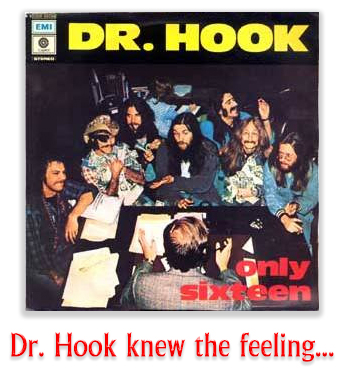We post news and comment on federal criminal justice issues, focused primarily on trial and post-conviction matters, legislative initiatives, and sentencing issues.
A TALE OF TWO GIRLFRIENDS
Jim and his girlfriend “Sweetie” had a brief fling a few years ago. The allure wore off for Sweetie pretty quickly. Now sick of Jim, she moved a thousand miles away.
 Jim did not take rejection well. He began sending emails, texts and Facebook messages demanding that Sweetie apologize to him for breaking it off.
Jim did not take rejection well. He began sending emails, texts and Facebook messages demanding that Sweetie apologize to him for breaking it off.
When she refused, Jim used social media to portray Sweetie as a stripper and prostitute, sending the lies to her new employer and generally spreading the meme to the four corners of the Internet. He told Sweetie and her family he would keep it up until she apologized. Sweetie found it pretty upsetting.
Jim was charged with interstate stalking, which he moved to dismiss on the grounds he had a 1st Amendment right to say whatever he wanted to. Problem is that the law is a bit more complex. It holds that “speech integral to criminal conduct” is not protected by the 1st Amendment.
 The district court said Jim was committing extortion under 18 USC 875(d), making prosecution of him for interstate stalking permissible despite his asserted 1st Amendment right.
The district court said Jim was committing extortion under 18 USC 875(d), making prosecution of him for interstate stalking permissible despite his asserted 1st Amendment right.
Jim argued that he was not extorting Sweetie, because extortion required that one person threaten to injure the reputation of another with the intent to extort a “thing of value” from that person. Jim said all he wanted was an apology, and, after all, what’s an apology worth, anyway?
Last week, the 8th Circuit upheld his conviction. The Court found that a “thing of value” includes intangibles. The focus, the Court said, is on whether the defendant thinks what is demanded is of value. Here, regardless of how much the apology might really have been worth, it was clearly a “thing of value” to Jim. Thus, he was extorting Sweetie, and his speck thus was integral to a crime.
 Meanwhile, a couple hundred miles away from Jim and Sweetie, Rod had struck up an Internet friendship with a 17-year girl in another state. The young girlfriend, whom we’ll simply call “Honeybunch,” lived in an unhappy home environment and was aching to get out of there. Rod sent her money for a bus ticket to come to live with him several states away in Texas (where the romance, he conceded, would have included some “honey” from Honeybunch in the form of consensual and loving sex).
Meanwhile, a couple hundred miles away from Jim and Sweetie, Rod had struck up an Internet friendship with a 17-year girl in another state. The young girlfriend, whom we’ll simply call “Honeybunch,” lived in an unhappy home environment and was aching to get out of there. Rod sent her money for a bus ticket to come to live with him several states away in Texas (where the romance, he conceded, would have included some “honey” from Honeybunch in the form of consensual and loving sex).
The plan fell apart before Honeybunch could even get as far as the state line. Honeybunch’s family found her missing, and panicked. When they found Rod’s phone number among things Honeybunch had left behind, they called him. Rod counseled the girl by phone to go back home, which she did.
That was not enough for the family, whose panic quickly turned to ire. They convinced the feds to prosecute Rod under the Mann Act, for knowingly transporting someone under 18 in interstate commerce “with intent that the individual engage in… sexual activity for which any person can be charged with a criminal offense.” The age of consent in Honeybunch’s home state was 18, but Rod argued that any sex would have occurred in Texas, where the age of consent was 17. Rod argued the 1st Amendment protected his communications with Honeybunch, because he did not urge her to do anything that would have been a crime where he proposed doing it.
 Last week, the 8th Circuit denied Rod’s 2255 motion, too. Sure, it agreed, the age of consent in Texas is 17 years old. But it found another Texas statute that made it a crime to “employ, authorize, or induce a child younger than 18 years of age to engage in sexual conduct,” including “sexual contact, actual or simulated sexual intercourse.” Rod was right that Texas allowed him to have sex with a 17-year old, but Texas nevertheless made it a crime for him to say or do anything that might convince the 17-year old to have sex with him.
Last week, the 8th Circuit denied Rod’s 2255 motion, too. Sure, it agreed, the age of consent in Texas is 17 years old. But it found another Texas statute that made it a crime to “employ, authorize, or induce a child younger than 18 years of age to engage in sexual conduct,” including “sexual contact, actual or simulated sexual intercourse.” Rod was right that Texas allowed him to have sex with a 17-year old, but Texas nevertheless made it a crime for him to say or do anything that might convince the 17-year old to have sex with him.
So in Texas, you can have sex with a 17-year old if you just lie there. But if you’re at all interested, you could end up with 10 years in federal prison. Charles Dickens was right: “‘If the law supposes that,’ said Mr. Bumble, squeezing his hat emphatically in both hands, ‘the law is a ass – a idiot’.”
United States v. Hobgood, Case No. 16-3778 (8th Cir., Aug. 22, 2017)
United States v. Goodwin, Case No. 16-1669 (8th Cir., Aug. 25, 2017)

11th CIRCUIT GOES ROGUE AGAIN, THIS TIME ON ‘VIOLENT FORCE’
Since the Supreme Court decided in the 2010 Curtis Johnson v. United States case that “force” meant “violent force—that is, force capable of causing physical pain or injury to another person,” circuits have been determining whether force was “violent” by asking whether it was likely to cause pain. Trust the 11th Circuit to upend that logical approach with a 67-page en banc decision holding that everyone is wrong: violent force only needs to be “capable” of causing physical pain. Degree of force no longer matters: only the effect does.
The ruling came last Friday in a reversal of an earlier 3-judge decision that Florida’s felony battery offense is categorically not a violent crime.
 Five dissenting judges point out that Florida felony battery “criminalizes a mere touching that happens to cause great bodily harm… A mere touching is not violent—it does not involve a substantial degree of force. A tap on a jogger’s shoulder that happens to cause the jogger to suffer a concussion is still just a tap.” The dissenters complaint that “the Majority’s decision cannot be reconciled with Curtis Johnson… Johnson explain[s] over the course of several pages that “physical force” refers to a threshold degree of force. But the Majority, reading this lengthy analysis out of Curtis Johnson, creates a new test for “physical force” that disregards degree of force. Although the Supreme Court has cautioned against reading a statement from one of its opinions “in isolation” rather than “alongside” the rest of the opinion, the Majority does exactly that.”
Five dissenting judges point out that Florida felony battery “criminalizes a mere touching that happens to cause great bodily harm… A mere touching is not violent—it does not involve a substantial degree of force. A tap on a jogger’s shoulder that happens to cause the jogger to suffer a concussion is still just a tap.” The dissenters complaint that “the Majority’s decision cannot be reconciled with Curtis Johnson… Johnson explain[s] over the course of several pages that “physical force” refers to a threshold degree of force. But the Majority, reading this lengthy analysis out of Curtis Johnson, creates a new test for “physical force” that disregards degree of force. Although the Supreme Court has cautioned against reading a statement from one of its opinions “in isolation” rather than “alongside” the rest of the opinion, the Majority does exactly that.”
United States v. Vail-Bailon, Case No. 15-1035 (11th Cir., Aug, 25, 2017)

3rd CIRCUIT HOLDS 2241 AVAILABLE WHEN 2255 IS NOT
We have written before about the Circuit split on whether a prisoner can use a 28 USC 2241 to challenge his or her guilt when there has been an intervening change in statute. Nine circuits say the saving clause of 28 USC 2255(e) permits it. Two, the 10th and 11th, do not.
A case challenging the 11th Circuit’s ban is awaiting grant of review by the Supreme Court, and some heavyweight legal talent is lining up to urge the issue on the high court. Meanwhile, the 3rd Circuit last week recognized the circuit split while reaffirming its commitment to maintaining 2241 as a safety valve.
 Gary Bruce was involved in a rather ugly robbery/murder years ago in Tennessee. Among other crimes, he was convicted of witness tampering murder, for killing to “prevent the communication by any person to a law enforcement officer or judge of the United States of information relating to the commission or possible commission of a Federal offense.” Gary’s jury was not instructed at all about whether it had to find Gary thought the witnesses might communicate with a federal officer. At the time, the law said that “no state of mind need be proved with respect to the circumstance… that the law enforcement officer is an officer or employee of the Federal Government.”
Gary Bruce was involved in a rather ugly robbery/murder years ago in Tennessee. Among other crimes, he was convicted of witness tampering murder, for killing to “prevent the communication by any person to a law enforcement officer or judge of the United States of information relating to the commission or possible commission of a Federal offense.” Gary’s jury was not instructed at all about whether it had to find Gary thought the witnesses might communicate with a federal officer. At the time, the law said that “no state of mind need be proved with respect to the circumstance… that the law enforcement officer is an officer or employee of the Federal Government.”
Later, the Supreme Court held that the statute required that the jury find that it was “reasonably likely under the circumstances that (in the absence of the killing) at least one of the relevant communications would have been made to a federal officer.” This was a new rule of substantive law not dictated by precedent existing at the time Gary was convicted, that narrowed the scope of the statute.
The Court said it permitted a 2241 when two conditions are satisfied: First, a prisoner must assert a “claim of actual innocence’ on the theory that… an intervening Supreme Court decision” has changed the statutory case law in a way that applies retroactively in cases on collateral review. Second, the prisoner must have had no earlier opportunity to challenge the conviction with a 2255 since the intervening Supreme Court decision issued.

Some other circuits allowing 2241s have stricter standards, requiring that prisoners show that circuit precedent foreclosed the issue at the time the 2255 was due. Here, Gary’s brother Bob was locked up in a different circuit that had such a rule. The 3rd noted the unfairness of the disparate treatment, noting that while Congress enacted Sec. 2255 to “alleviate the inefficiencies that attend 2241’s… rules, now those difficulties have returned, though in a new form. And so they will remain, at least until Congress or the Supreme Court speaks on the matter.”
Bruce v. Warden, Case No. 14-4284 (3rd Cir., Aug. 22, 2017)
McCarthan v. Goodwill Industries, Petition for Writ of Certiorari, Case No. 17-85 (Supreme Ct., filed July 17, 2017)
– Thomas L. Root

